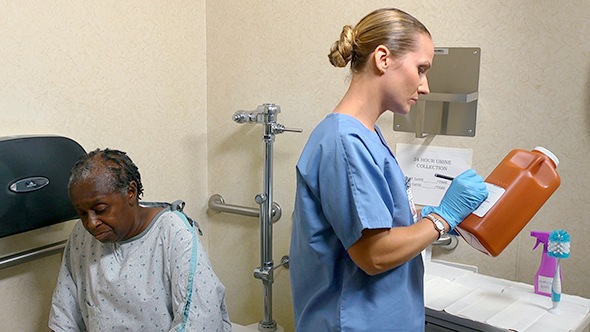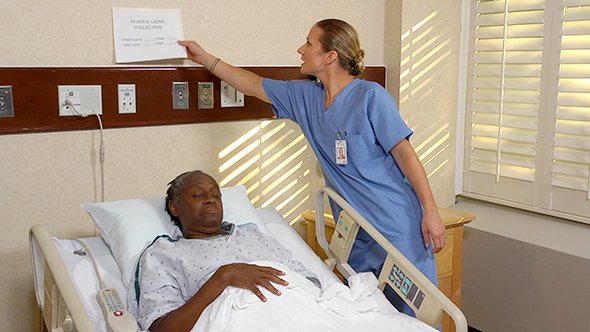Specimen Collection and Surgical Care
Select a Skill:
- » Collecting a Midstream Specimen
- » Collecting a 24-Hour Urine Specimen
- » Collecting and Testing a Stool Specimen
- » Collecting a Sputum Specimen
- » Measuring Blood Glucose
- » The Surgical Skin Prep—Shaving the Skin
- » Assisting with Deep Breathing and Coughing Exercises
Take the Review Test:

Purpose

- Urine specimens are collected for urine tests.
- All urine voided during a 24-hour period is collected for a 24-hour urine specimen. Urine is chilled on ice or refrigerated during this time. This prevents the growth of microbes. For some tests, a preservative is added to the collection container.
- The person voids to begin the test with an empty bladder. Discard this voiding. Save all voidings for the next 24 hours. The test is restarted if:
- A voiding was not saved.
- Toilet tissue is discarded into the specimen.
- The specimen contains stools.
- Follow these rules for collecting urine specimens:
- Follow the rules of medical asepsis.
- Use a clean container for each specimen. Use the correct container.
- Do not touch the inside of the container or lid.
- Label the container in the person’s presence. Provide clear, accurate information.
- Collect the specimen at the correct time.
- Ask a female if she is menstruating. Tell the nurse. Menstruation may cause blood to be in the urine specimen.
- Instruct the person. The specimen must not contain stools or toilet tissue.
- Place the specimen container in a labeled BIOHAZARD plastic bag. Do not let the container touch the outside of the bag. Seal the bag.
- Take the specimen and requisition slip to the laboratory or storage area.
Equipment
Roll cursor over items to see labels. For the purposes of clearly depicting the equipment, a barrier is not shown in this photo. When providing care, a barrier should always be placed on the surface before placing the equipment.

Basin (for ice if needed)
Specimen bag
Garduate to meausure output
Urine container for a 24-hour collection
Specimen label
Specimen pan
Funnel
Gloves
Two 24-HOUR URINE labels
Laboratory requisition slip
Delegation
- Follow delegation guidelines. Before collecting a urine specimen, obtain this information from the nurse and care plan:
- Voiding device used—bedpan, urinal, commode, or toilet with specimen pan
- The type of specimen needed
- What time to collect the specimen
- What special measures are needed
- If you need to test the specimen
- If measuring intake and output (I&O) is ordered
- What observations to report and record
- When to report observations
- What patient or resident concerns to report at once
Preparation

- Observe quality-of-life measures.
- Review the information under Delegation and Safety and Comfort.
- Practice hand hygiene.
- Before going to the person’s room, collect the items on the equipment list, from the laboratory requisition slip through gloves.
- Arrange collected items in the person’s bathroom.
- Place one 24-HOUR URINE label in the bathroom. Place the other near the bed.
- Practice hand hygiene.
- Identify the person. Check the ID bracelet against the requisition slip. Compare all information. Also call the person by name.
- Label the urine container in the person’s presence. Apply the biohazard label. Place the labeled container in the person’s bathroom.
- Put on gloves.
- Collect the remaining items on the equipment list.
- Provide for privacy.
Safety

- Blood, body fluids, secretions, and excretions may contain blood and microbes. This includes urine specimens. Follow Standard Precautions and the Bloodborne Pathogen Standard when collecting, testing, and handling specimens.
- The urine container or preservative may contain an acid. Do not get the preservative or urine from the container on your skin or in your eyes. If you do, flush your skin or eyes with a large amount of water. Tell the nurse what happened and check the material safety data sheet (MSDS). Also complete an incident report.
- Keep the specimen chilled to prevent the growth of microbes. If not refrigerated, place the urine container in a bucket with ice. Add ice to the bucket as needed.
- Assist the person with hand washing after every voiding. This prevents the spread of microbes that may be in the urine.
Comfort
- Urine specimens may embarrass some people. They do not like clear specimen containers that show urine. It may be helpful to place the specimen container in a paper bag. Or provide a paper towel or washcloth to wrap around the container.
Procedure Video
Audio Description: OFFFollow-up Care

- Provide for comfort.
- Place the call light within reach.
- Raise or lower the bed rails. Follow the care plan.
- Put on gloves.
- Remove the labels from the room and bathroom.
- Clean, rinse, dry, and return equipment to its proper place. Discard disposable items.
- Remove and discard the gloves. Practice hand hygiene.
- Unscreen the person.
- Complete a safety check of the room.
- Take the specimen (labeled urine container) and requisition slip to the laboratory or storage area. Wear gloves.
- Remove and discard the gloves. Practice hand hygiene.
Reporting/Recording
- Report and record your observations, including:
- Problems obtaining the specimen
- Color, clarity, and odor of urine
- Blood in the urine
- Particles in the urine
- Complaints of pain, burning, urgency, difficulty voiding, or other problems
- The time the specimen was collected
Review Questions
Select the best answer.
1. For a 24-hour urine specimen, where should you place the 24-HOUR URINE labels?
 In the bathroom and near the bed
In the bathroom and near the bed Near the bed and on the specimen container
Near the bed and on the specimen container Near the bed and on the person’s ID bracelet
Near the bed and on the person’s ID bracelet In the bathroom and near the door to the person’s room
In the bathroom and near the door to the person’s room
Select the best answer.
2. How should a person begin a 24-hour urine collection?
Select the best answer.
3. Which factor would require you to restart 24-hour urine collection?
 The urine specimen appears cloudy.
The urine specimen appears cloudy. The urine specimen has particles in it.
The urine specimen has particles in it. The person saves a voiding in a specimen pan.
The person saves a voiding in a specimen pan. The person discards toilet tissue into the specimen.
The person discards toilet tissue into the specimen.
Select the best answer.
4. When collecting a 24-hour urine specimen, some of the preservative from the container gets on your skin. What should you do right away?
 Flush your skin.
Flush your skin. Replace your gloves.
Replace your gloves. Practice hand hygiene.
Practice hand hygiene. Put more preservative in the container.
Put more preservative in the container.
Select the best answer.
5. During 24-hour urine collection, what should you do after every voiding?
 Take the urine specimen to the laboratory.
Take the urine specimen to the laboratory. Put the urine specimen in the storage area.
Put the urine specimen in the storage area. Remove the labels from their posted locations.
Remove the labels from their posted locations. Use a funnel to pour urine into the urine container.
Use a funnel to pour urine into the urine container.
You have completed the Review Questions for this skill. To take the Review again select the Start Over button. To proceed to another skill select from the dropdown menu. Select the Home or Back button to proceed to the next section.

